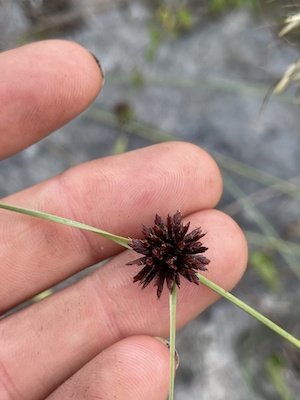Plants of South Florida · Plants by Conservation Area · Plants by County · Plants by Habitat Quick Search · Advanced Search |
||
|
|
||
 |
Cyperus fuligineus Chapm. Limestone flatsedge |
|
|
South Florida Status: Critically imperiled. Four occurrences in three conservation areas (Long Key State Park; National Key Deer Refuge, Snake Creek Hammocks) and one non-conservation area (Valhalla Rock Barren Site). Taxonomy: Monocotyledon; Cyperaceae. Habit: Perennial terrestrial herb. Distribution: Native to South Florida and the West Indies. South Florida Distribution: Monroe County Keys. South Florida Habitats: Rockland hammocks, coastal berms, and coastal rock barrens. Protection Status: Listed as endangered by FDACS and as critically imperiled by FNAI. Aids to Identification: There are about 50 species of Cyperus in Florida. Wunderlin (1998) has a key. The stems and spikelets are rusty reddish. References: Chapman, 1883; Small, 1933a; McLaughlin, 1944; Long & Lakela, 1976; Correll & Correll, 1982; Wunderlin, 1998; Coile, 2000; Liogier & Martorell, 2000. Synonyms: None. Historical Context: Limestone flatsedge was collected first on the island of Key West either by John Loomis Blodgett, between 1838 and 1853 (s.n., NY), or by Ferdinand Rugel in 1846 (s.n., F). It was observed there by J. Cosmo Melville in 1872 (Melville, 1882) and was collected there by Abram P. Garber in 1877 (s.n., NY). John Kunkel Small and others made another collection, probably in 1913 (the label is damaged), on Key Largo, and in 1919, Small and Nathaniel L. Britton made a collection on Upper Matecumbe Key (9332, NY). The next collection was made by Small in 1921 on the southern end of Big Pine Key (10147, NY), presumably in Cactus Hammock, where Ellsworth P. Killip collected it in 1952 (41958, F), George N. Avery collected limestone flatsedge in 1971 (1975, FTG), and Bradley observed it several times from 1995-2001. Donovan S. Correll and Helen B. Correll also collected limestone flatsedge on the northern end of Big Pine Key in 1982 (54042, FTG). In 1965, George N. Avery observed plants in a hammock at the southwestern point of Ramrod Key, at the Ramrod Key Coastal Berm Site (Avery’s Notes, 12 December 1965). This station was not vouchered. The property is still undeveloped and plants could remain there. Part of this site is owned by Monroe County and part is privately owned. In 1966, Avery observed limestone flatsedge on Crawl Key at the Valhalla Rock Barren Site (Avery’s Notes, 19 April 1966). Bradley also observed this station in 1998, where perhaps a few hundred plants are extant. This is a privately owned site immediately adjacent to Curry Hammock State Park. In 1995, Bradley discovered limestone flatsedge in a coastal rock barren at the Long Key State Park (249, USF, FTG), where it is extant. Bradley, Gann, and Florida Park service biologist Janice A. Duquesnel observed plants there in 2000. Bradley also found plants in 1999 at the edge of a rockland hammock on Plantation Key at Snake Creek Hammocks, Florida Keys Wildlife and Environmental Area. This station was mapped, but needs to be vouchered. Major Threats: Habitat destruction at the Valhalla Rock Barren; exotic pest plant invasions. Recommendations: • Voucher plants at Snake Creek Hammocks. • Survey Ramrod Key Coastal Berm Site. • Map and monitor known stations on a regular basis. • Acquire privately owned portion of Ramrod Key Coastal Berm Site. Designate and manage the entire site as a conservation area. Acquire Valhalla Rock Barren Site. • Consider introducing limestone flatsedge to other sites within its historical range, including Little Hamaca Park. |
||



